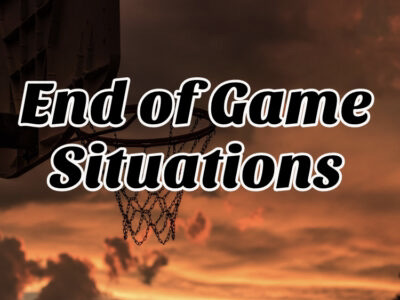Basketball End of Game situations refer to the specific scenarios and strategies that teams employ in the closing moments of a basketball game when the score is close and every possession becomes critical. These situations typically involve various tactics aimed at maximizing scoring opportunities, managing the clock, and maintaining or gaining a competitive advantage.
It’s important to note that end-of-game situations can vary depending on the specific rules and regulations of different basketball leagues and organizations. Coaches and players often develop unique strategies and adjustments based on their team’s strengths, the opponent’s weaknesses, and the game’s context.
Here’s a look at seven elements basketball coaches should consider when dealing with End of Game situations.
7 Elements to Consider During Basketball End of Game Situations
- Game-Winning/Go-Ahead Possession: When a team is trailing by a small margin or tied, they have the opportunity to execute a play to score and take the lead or win the game.
- Clock Management: Teams need to be mindful of the game clock and shot clock in order to maximize their possessions and prevent the opposing team from having enough time for a comeback. This may involve intentionally fouling to stop the clock, strategic timeouts, or using quick fouls to send the opponent to the free-throw line and conserve time.
- Free-Throw Strategies: Depending on the score and time remaining, teams may employ different strategies when shooting free throws or defending against them. This can include intentionally missing a free throw to create an opportunity for an offensive rebound or committing intentional fouls to prevent the opposing team from attempting a potential game-tying or game-winning shot.
- Inbound Plays: Out-of-bounds situations, especially when the offensive team is near their basket with limited time, require well-designed plays to create open scoring opportunities. These plays often involve screens, cuts, and decoy movements to confuse the defense.
- Three-Point Shooting: With the increased value of three-pointers, teams may strategically seek three-point shots to quickly close a scoring gap or take the lead.
- Defensive Strategies: Teams may employ specific defensive strategies, such as full-court pressure, double-teaming star players, or denying certain passes, to disrupt the opposing team’s offensive flow and force turnovers.
- Overtime Strategies: When a game is tied at the end of regulation, teams enter an overtime period with additional time to determine the winner. Overtime basketball strategies are similar to end of game situations, but teams need to adapt and adjust their approach based on the game’s flow and player fouls.
Prepping for Basketball End of Game Situations
Preparing for end of game situations are crucial for basketball coaches at any level. Often times, however, this remains overlooked when developing their practice plans. Coaches continually drill aspects of an offensive set or a defensive approach, but sometimes forget those end-of-game scenarios.
Competitive practice games stand as one useful tool. These drills inject energy into practice that’s usually reserved for game nights. Competitive games, especially ones where the losing team feels the consequences, allow coaches to bring a high-level of energy to the practice floor.
Another thing basketball coaches should consider is developing specific in-practice scenarios to prepare for those end of game situations. These scenarios might play out during a controlled scrimmage. But adding specific elements like time and score will aid in that preparation. Something like, asking a team to hold a single-digit lead for three minutes. Or maybe the “best” player is not available due to foul trouble. Options are only limited by the coach’s creativity.
Check out the YouTube link below for a specific discussion between coaches on how to deal with end of game situations. In this segment, coaches use real game footage to talk through the options available.
Related: Defensive Drills and Rebounding Techniques
Resources:
If you found this useful, don’t forget to check out additional blog posts at TeachHoops.com. Also, check out TeachHoops on Facebook, Twitter, Instagram and YouTube.




